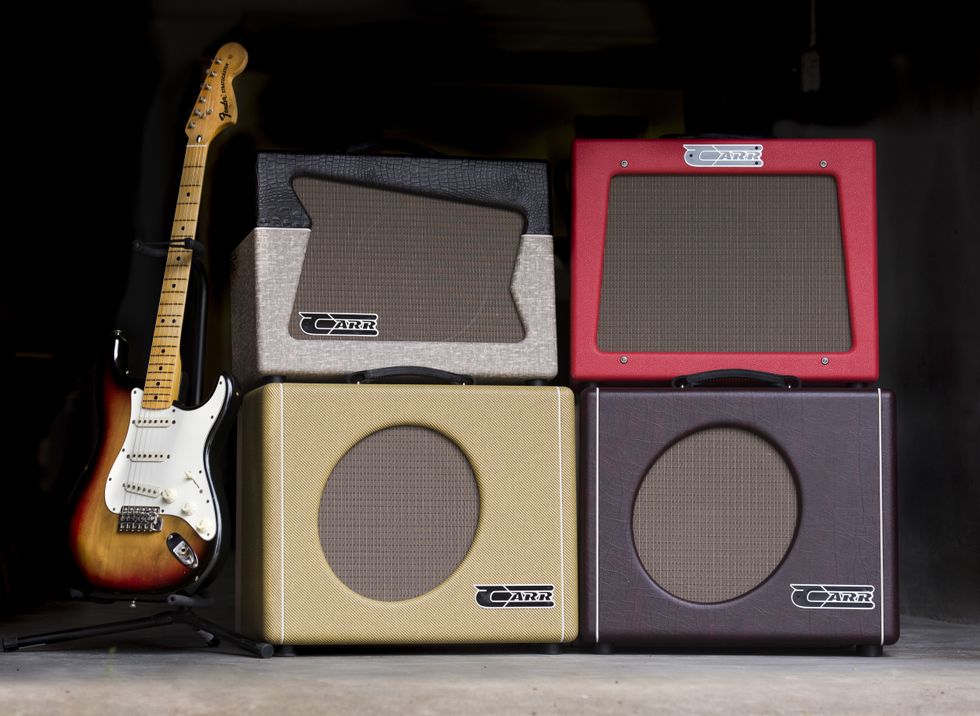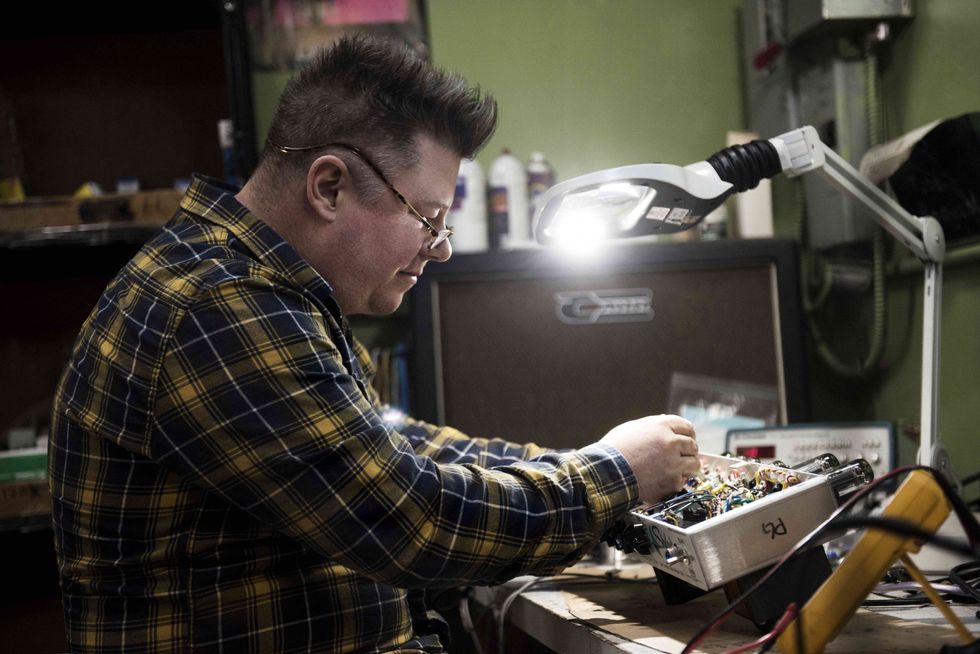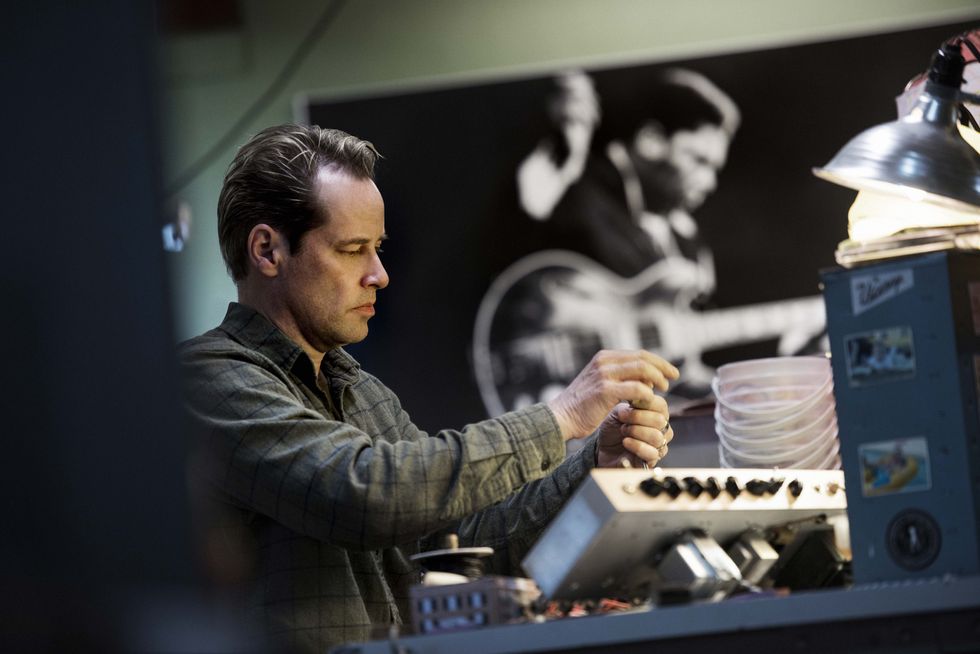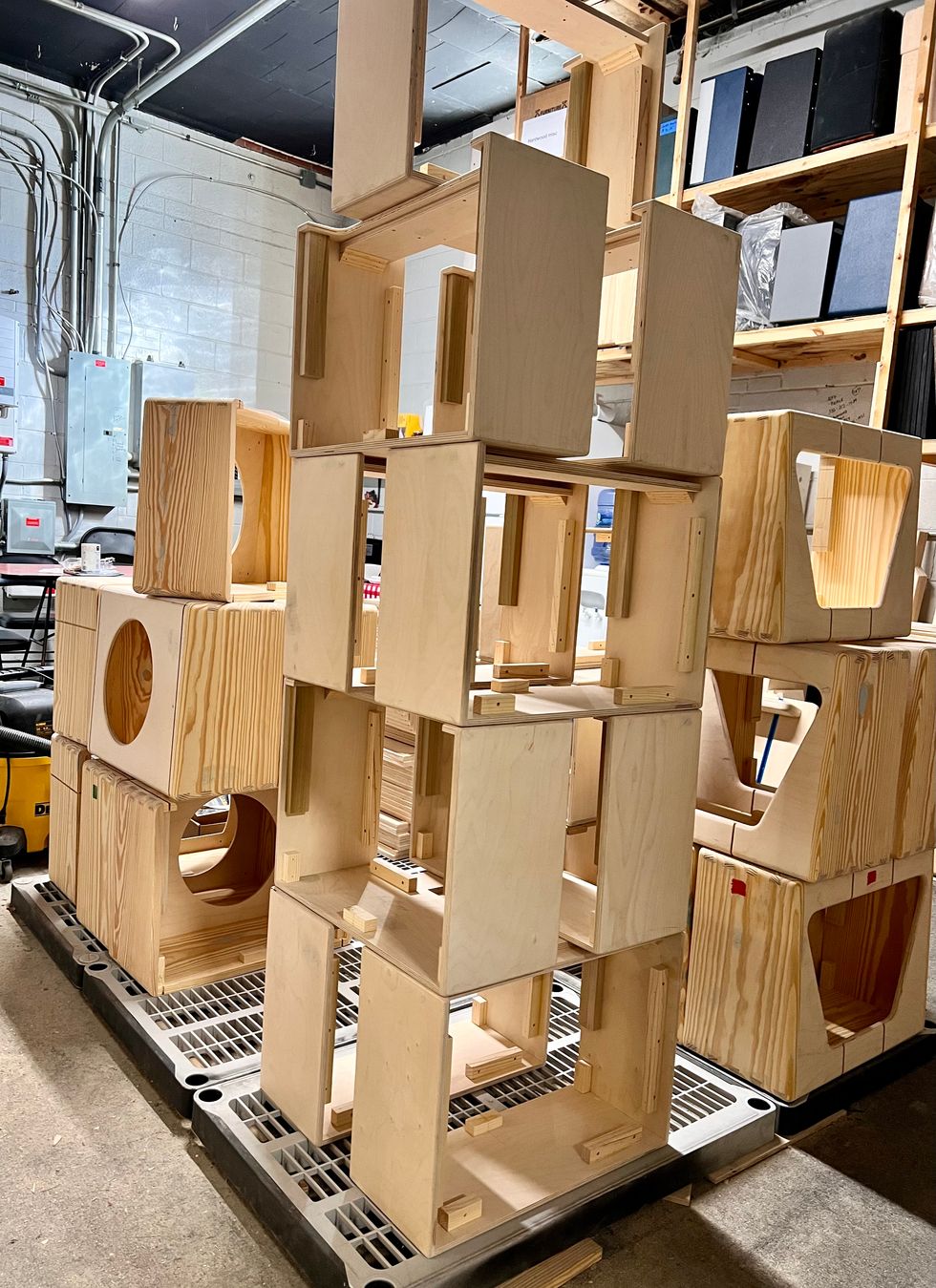Steve Carr started building amps because he loved playing guitar. He and his friends cobbled together a band in Michigan City, Indiana, in high school in the mid-’70s, and the gear they played with seemed like a black box. In the pre-internet days, getting information on amp voicings and pickup magnets was difficult. Carr was fascinated, and always wanted to know what made things tick.
After college, he moved to Chapel Hill, North Carolina, where he met an amp repairman that he started hanging around. He wanted to apprentice under the fellow and soak up his wisdom, but the guy wasn’t interested in taking on a student. “Finally, he said, ‘I don’t have time to have anybody around here, but you should do what I did when I was a kid, which is build a Fender tweed Champ,’” remembers Carr. He’d have to track down the schematic, figure out how to read it, source the necessary parts, then assemble the amp. Flipping through issues of Vacuum Tube Valley and Angela’s Instruments, he got on his way.
Building that Champ clone taught him how to navigate industrial parts suppliers, valuable know-how that would come in handy later on. At the end of the build, he flicked it on, and nothing happened. The amp wouldn’t sing. “I was super depressed,” Carr says. “I couldn’t believe it.” But he didn’t quit—he spent the next few weeks troubleshooting the circuit and got it to go. By then, in his mind, he was a bona fide amp repairman. Between Chapel Hill, Raleigh, Durham, and Greensboro, there were tons of young gigging bands who needed their amps in working order, so Carr got a breakneck crash course in amp repair over a few years. It wasn’t long before he thought: “Maybe I can make my own amp.”

Carr’s lineup has included 22 different amplifier models over its 26 years of business. Clockwise from top left, we have the Skylark, Rambler, and two Mercury Vs.
Photo by Tim Coffey
His initial idea was to combine two amps that he loved, his black-panel Fender Deluxe Reverb and 50-watt non-master-volume Marshall. He wanted to marry the Fender’s cleans and reverb with the roaring drive of the Marshall. The Frankenstein experiment produced Carr Amplifiers’ first amp: the Slant 6V. It was just intended for Carr’s personal use. But it wasn’t too long until his friends encouraged him to build more, and in the fall of 1998, he made his first two sales.
Eddie Berman was working at the Music Loft in Wilmington, North Carolina, when a local musician called him up to say that a friend of his was building amplifiers, and wanted to bring one by the shop. Carr brought those first two Slant 6Vs by, and Berman and his colleagues jammed on them at rehearsal that evening. “I went, ‘Oh my goodness, we have to have these amplifiers,’” says Berman. The clean channel was unbelievable, Berman continues—broad, cinematic, and sweet-sounding, free from any top-end harshness or “nails on the chalkboard” overtones. It was so intoxicating that he used to tease Carr: The clean channel was so good, why did he bother to put a dirty channel on, too?
There was more to the amps than just rich tone. Berman remembers that the first amp had the same electrical plug as one might find on hospital emergency room equipment. “We know anything that he touches is going to be golden,” says Berman. There was one other element, too: Steve Carr was just a good dude. Ph

From his very first build, Carr has manufactured his amps to impressive, durable specs—two different sources mentioned independently how robust and secure that even the amplifiers’ power cords are.
Photo by Tim Coffey
That was more than 26 years ago. Carr Amplifiers, located in Pittsboro, North Carolina, has grown into one of the most respected companies in the boutique amplification market, thanks to their versatility, exacting construction, and, of course, beautiful sounds.
In his first builds, Carr pioneered a combination that would become a signature for all his models: expensive polypropylene capacitors and more classic, old-school components like carbon-composition resistors. “Those two items have a certain sound that is a family trait in the amps, which is a very dynamic, open, transparent, but also a very warm and liquid sound, at once,” says Carr. “They’re sort of in a way opposite concepts, but they come together.”
Carr attributes his success in part to the initial demise of Matchless, the amp builder that helped carve out the beginnings of the boutique amp niche in the 1990s. When Matchless went out of business in 1998 (they returned some years later), Carr realized that their dealers would probably be looking for replacement amps in their shops to appease the boutique crowd, so he phoned them up and pitched his amps.
“Those two items have a certain sound that is a family trait in the amps, which is a very dynamic, open, transparent, but also a very warm and liquid, sound at once.” - Steve Carr
The business grew, and in May 1999, the Carr brand launched its second amp, the Rambler. Carr describes it as “a collage” of a black-panel Princeton Reverb and a tweed Pro. By this point, the rising amp-maker had solidified another characteristic: He liked squeezing two amps into one box, without sacrificing fidelity on either end. “At first, they don’t really want to work well together,” says Carr. There’s a whole lot of prototyping to get to the point where the circuits can behave copacetically, and represent both elements of their parent amplifiers without causing problems. But succeeding in that analog alchemy is one of Carr’s greatest achievements. “It’s got influences,” he continues, “but it becomes a new, unique amp.”

Working with expensive components, like choice capacitors and near-obsolete resistors, drives the price of Carr amps up, but Steve Carr insists that they make an audible difference. Here, Carr builder David Quick assembles a Mercury V.
Photo by Tim Coffey
Carr started building his noiseboxes out of the spare bedroom of his wife’s home in southern Chapel Hill, and after his first sales, he sprang for a wooden-floored barn in the woods. It had electricity, but that was about it: no HVAC, no water, no bathrooms. But the price was right, so he rented the spot and hired his first employee. The operation lasted a year there, where they built Slant 6Vs and Ramblers, the latter of which became the company’s first perennial seller and a favorite of Nashville session players. “The names of these folks, people may not know, but you’ve probably heard a lot of these session guys who’ve got Ramblers,” says Carr.
The “barn era” lasted about a year and a half, until Carr and his wife relocated to Pittsboro. He got a tip that some space was up for rent in an old chicken hatchery downtown, where they leased two rooms initially. When the business in the neighboring units moved out, Carr Amplifiers expanded to 4,500 square feet. They’ve remained in that building since, growing the operation to fill the high ceilings and spacious rooms.
One of the major additions to the business was in-house cabinetry building. In the early years, Carr hired carpenters from around the state who built cabinets for the amps. At one point, he was picking up cabs from a woodworker named Peter Mather in Virginia Beach, Virginia, loading up a van with 30 of the wooden frames. Even though it was wintertime, Carr drove with the windows down, because the glue applied to adhere the Tolex to the wood was still fresh, and the fumes were potent. Eventually, Mather, who passed away in 2023, offered to travel to Pittsboro to teach Carr and his staff how to manufacture the boxes. The onsite cabinet-making started in 2003, and in the two-decades-plus since, the team has developed their distinctive cabinet design into a key piece of their identity. It’s important that Carr cabs both look great and fit the physical needs of the circuitry inside.

At Carr, the name of the game is cutting cabs, not corners. Here, a stack of naked Bel-Ray frames show off the shop’s woodworking and design prowess.
Photo courtesy of Carr Amplifiers
“We have a certain aesthetic sense,” says Carr, naming 1920s through ’60s design and art trends, chiefly art deco, as major influences. “I’ve always wanted to have that in the cabinets, because so many guitar amps are very basic-looking, and if somebody’s buying something that’s handmade with great care, it seems to me that you want to make it fun-looking, too. You want to take that same care with the whole aesthetic look of it and make it a real pleasure to have. That’s been a goal from the beginning, and it’s part of why we decided to take the extra expense. There are a lot of machines you’ve got to buy to create a cabinet shop. But now we have control over the beauty of the design.”
But the box is only as good as what comes out of it. Carr says it takes roughly nine months of process between when he brainstorms a design and when it comes to life, but it always starts with a classic amp—or a few. “I often joke that it’s kind of a sonic divining rod, where I’ll start off somewhere and the amp eventually becomes what it wanted to become,” says Carr. “I’m just along for the ride.”
“I often joke that it’s kind of a sonic divining rod, where I’ll start off somewhere and the amp eventually becomes what it wanted to become. I’m just along for the ride.” - Steve Carr
The Bel-Ray, released earlier this year, is Carr’s most ambitious design yet. Previous builds like the Super B and Mercury V incorporated rotary switches that allowed users to change between specific voicings—already a mean feat in a small combo with analog circuitry. But Carr wanted to take it a step further and create a combo amp with a “triumvirate of British amp voices”: classic Vox, Marshall, and Hiwatt noisemakers. It was a big challenge, he admits. The output section was fairly simple—two EL84 tubes—but Carr wanted to incorporate an EF86 pentode in the preamp. It has a distinct flavor from the two other 12AX7s in the preamp, but is so dynamic that the potential for microphonic problems is elevated. That took some finessing.
The tone stacks, though, were the most labor-intensive code to crack. It took Carr a long time to get the feel for Hiwatt’s midrange and treble signatures, which he likens to those of old Valco and Supro amps. While the Marshall and Vox tone architecture were similar enough in structure, the Hiwatt’s was trickier to squeeze in. “The parts just don’t connect in the same places or in the same way, so you’re not able to just change a value here and there; you have to change how it’s all hooked up,” he explains. To accomplish the complex maneuvering, the Bel-Ray uses a number of dual, stacked pots, and the rotary switch changes not just capacitor values, but also which deck of the dual pots the user is manipulating. “There was a lot of massaging and tweaking and thinking to get all three of those vibes there,” he says. “And then, the amp became its own thing. It has characteristics of all those [amps], but it’s not exactly those.”
Carr Bel-Ray Amp Demo | First Look
PG’s John Bohlinger takes the Carr Bel-Ray through its paces in this First Look demo.
Search terms: Carr Bel-Ray Amp Demo First Look
Part of Carr Amplifiers’ “mojo” comes from Carr’s exacting standards for individual components, which contribute to the significant price tag on his amps. He favors U.S.-made signal capacitors from Ohio-based Jupiter Condenser Co., which are patterned after ’50s and ’60s caps but can cost 10 to 20 times more than the average capacitor. Another parts vendor sources him with his treasured, near-obsolete carbon-comp resistors. Unless you have a backstock (which he has amassed), Carr estimates you won’t be able to find them within a few years. This all might sound a bit over-the-top; how much difference can one tiny component make? Carr insists that when he’s testing components in the circuits, the value (pun intended, I guess) becomes clear.
“There’s a lot of really great amps out there, and I love a lot of amps. I’m not saying this is the only one, but it sure is a good one.” - Bill Frisell
It’s obvious that he’s onto something. In the early 2000s, Bill Frisell was in Nashville recording with bassist Viktor Krauss when Krauss loaned him a Carr Rambler to record with. He loved it. A while later, he played a Carr Mercury during a session in Portland, Oregon. “That’s where I really was like, ‘Oh man, I gotta check this out more,’” says Frisell. His parents were living in Chapel Hill, so during a visit, he popped down to Steve’s shop and picked up a Mercury of his own. When the Sportsman came out, Frisell bought one of those, too.
On the road, Frisell uses mostly Fender amps, but at home, he keeps his prized amplifiers: a small Gibson combo amp from the early ’60s, an early ’60s Fender Princeton, and his Carr Sportsman. “There’s this thing with these older amps,” says Frisell. “There’s a clarity and warmth that’s happening at the same time. I can’t put my finger on it when I try to describe the sound. Whatever it is with the Sportsman, that’s the one for me that has these qualities, these older amps that I love.
“There’s a lot of really great amps out there, and I love a lot of amps. I’m not saying this is the only one, but it sure is a good one.”

























